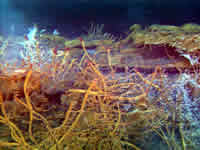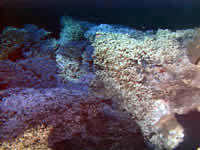| |
| |

Hot
water seeps up between the jumbled lava sheet flow at Cloud vent,
creating an environment where tubeworms and limpets live in this chemically
rich environment. White bacterial mat is abundant in this region.

Blue protozoan mat contrasts beautifully
with the white limpets seen here at Marker-N3 in 1526 meters of water.
|
|
NOAA Ship Ron Brown/ROV ROPOS
Science News
Science Report - Thursday, July 19, 2001
Ship's position: 45 45.3'/-130 02.0'
ROPOS
dive 622 was in the water for 24 hours and returned with a record number
of 46 samples from the seafloor. Of the 46 samples, 24 were from the
vent fluid sampler, 14 were miniature temperature recorders that were
recovered from last year, and the remaining 8 were suction samples. Dive
622 was focused on the Marker 33 / Cloud area, where crabs and vent fish
were seen for the first time, but the venting seems to have diminished
somewhat since last year.
On
the other hand, venting was more robust than expected at a site near the
northern end of the 1998 lava flow at Marker N3 (just south of Magnesia).
The Marker N3 area was observed to be venting over a large area with abundant
limpets and tubeworms, extensive areas covered with a blue-tinted protozoan
mat, and open cavities within the lava flow coated with white microbial
mat and expelling white "snowballs" of floc. We found that the
Magnesia area had ceased venting last year, so it is a little surprising
that the Marker N3 area is still going so strong. The fluid sampler has
two new in-situ sensors on it this year - one to measure pH and the other
to measure H2S - and both worked well. These same sensors will go on this
year's NeMO Net experiment - an interactive vent fluid sampling system
with two way communication. More on that later...
|
|

